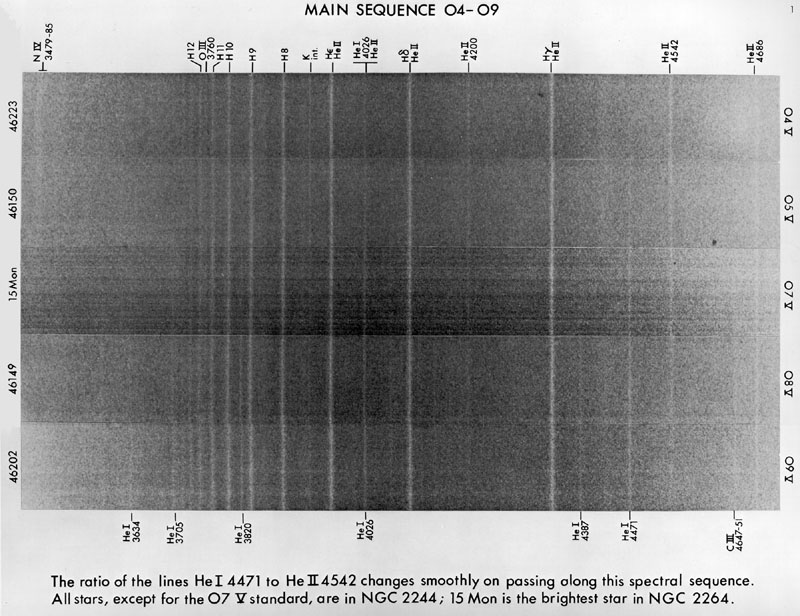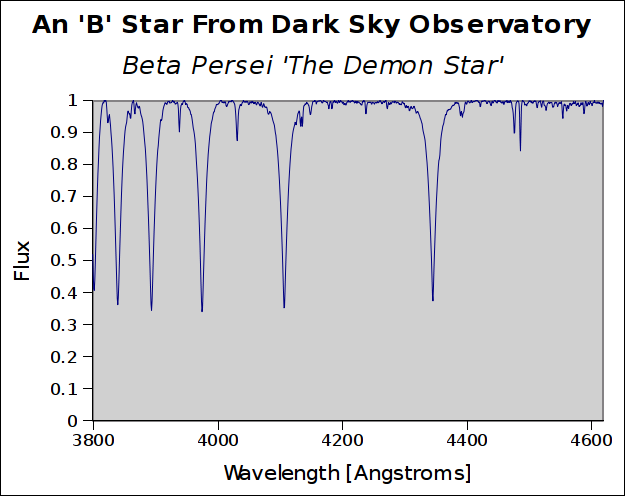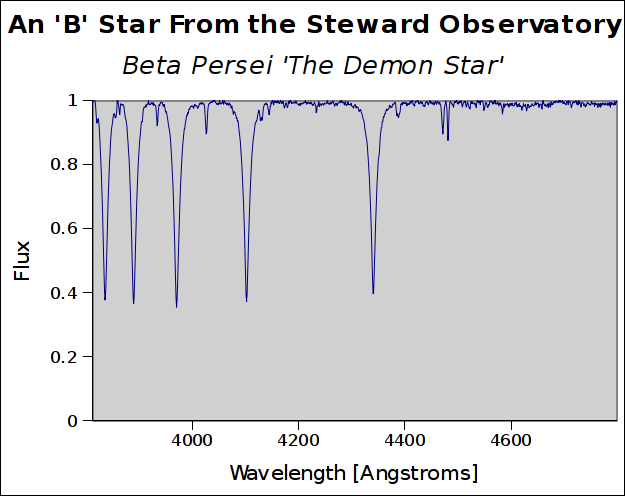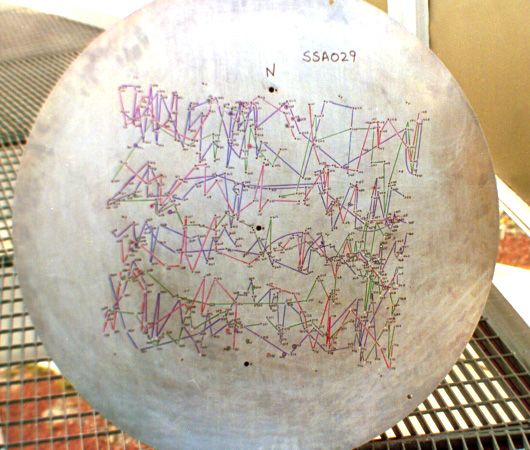
Overview of Stellar Spectra | Finding Spectra | Plotting and Measuring Spectra | Classifying Spectra | Links
The MKK system is defined by carefully selected standard stars. All other stars were compared to this select group of bright stars. The MKK book does not give quantitative analysis, instead he describes in words what one should see when looking at a class of star. It is up to the reader to interpret the data and apply it to the star he or she is observing.

A Stellar Spectrum on Photographic Plate, as used by MKK
Note that this is a photographic negative. So, the bright vertical lines indicate where the spectrum is darker due to an absorption line.
MKK looked at many stars, and left behind much data. However the data is in the form of photographic plates, and is impossible to compare with the digital data produced by the Sloan Digital Sky Survey. To complicate matters further, The Sloan was designed to look at dim objects unlike the bright standards MKK used for his system. The Sloan didn't take any images of standard stars. This means that none of MKK's standards were captured by the Sloan, and their spectra must be found elsewhere.
The Dark Sky Observatory is one of the telescopes that has spectra for the standard stars available. A full list of spectra from the Telescope is available here

A Stellar Spectrum from the Dark Sky Observatory, plotted in a spreadsheet program
This spectrum is plotted with the smooth black body curve removed, to make it easier to see absorption lines. On this plot, 1 means the intensity of the star at that wavelength has no absorption, down to 0, where all of the light at that wavelength is absorbed.
The Steward Observatory is one of the telescopes that has spectra for the standard stars available. A full list of spectra from the Telescope is available here

A Stellar Spectrum from the Steward Observatory, plotted in a spreadsheet program
The Sloan Digital Sky Survey is the telescope this project was designed for. The goal is to apply MKK's standards to the mass of publicly accessible data put forth by the Sloan. The Sloan has a different way of gathering data, in fact it has two complementary ways:
Direct download from the database is possible through the use of a Java program written by Chris Stoughton This program is simple to use if you follow these steps:
In order to determine the version of Java you have, type the following in the command line:
java -version
you should get something like
java version "1.6.0_20"
Java(TM) SE Runtime Environment (build 1.6.0_20-b02)
Java HotSpot(TM) Client VM (build 16.3-b01, mixed mode, sharing)
If you have a Java version less than 1.6, you need to update Java
cd C:\Documents and Settings\jbrown\My Documents\
Then you would typejava -jar "SpSpecToCSV.jar" 51690 306 114 5
Change everything inside the double quotes (") to the exact path of the downloaded filecd /Users/jbrown/Documents
Then you would typejava -jar SpSpecToCSV.jar 51690 306 114 5
cd /home/jbrown/Documents
Then you would typejava -jar SpSpecToCSV.jar 51690 306 114 5
51690 306 114 5
Tell the program which spectrum to retrieve and convert.51690
Is the 'mjd' or Modified Julian Date, which is a counter from a certain date, it tells you the night the spectrum was taken.306
Is the 'plate', which corresponds to the actual metal plate with holes drilled in it that was used in the SDSS.
An Aluminum Plate with holes drilled precisely at the location light from distant stars will hit
114
Is the 'fiberid', which corresponds to which hole in the plate the spectrum was taken on.5
Tell the program to average over five values. This helps by smoothing to reduce the effects of noise. Set this too high, however, and the spectrum becomes a line.SQL (Structured Query Language) is a publicly available database of all the processed data the SDSS has collected over the years. We can find spectra to directly download by writing a SQL Query. For a complete description of how to use SQL to analyze stars, use this document
Select top 5
mjd,plate,fiberid
from sppParams
Select top 5
mjd,plate,fiberid
from sppParams
where sptypea="m0"